
Feliformia
Encyclopedia
The Feliformia are a suborder within the order Carnivora
and includes cats
(large and small), hyenas, mongooses, civet
s and related taxa. The other suborder of Carnivora is Caniformia
("dog-like" carnivorans). One shared characteristic distinguishes Carnivora from all other mammals: the possession of the four carnassial
teeth in the front of the jaw.
The separation of Carnivora into the broad groups of feliforms and caniforms is widely accepted, as is the definition of Feliformia and Caniformia as suborders (sometimes superfamilies). The classification of feliforms as part of the Feliformia suborder or under separate groupings continues to evolve.
Systematic classifications dealing with only extant taxa[1,2] include all feliforms into the Feliformia suborder, though variations exist in the definition and grouping of families and genera. The extant families as reflected in the taxa chart at right and the discussions in this article reflect the most contemporary and well supported views (as at the time of writing this article). Molecular phylogenies show the Feliformia to be monophyletic[8].
Systematic classifications dealing with both extant and extinct taxa vary more widely. Some [4] separate the feliforms (extant and extinct) as: Aeluroidea (superfamily) and Feliformia (suborder). Others[3] include all feliforms (extant, extinct and "possible ancestors") into the Feliformia suborder. Recent studies suggest this inclusion of "possible ancestors" into Feliformia (or even Carnivora) may be spurious (Wesley-Hunt and Flynn 2005).[5] The extinct (†) families as reflected in the taxa chart at right are the least problematic in terms of their relationship with extant feliforms (with the most problematic being Nimravidae).
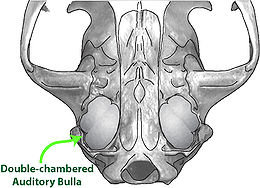 All extant feliforms share a common attribute: their auditory
All extant feliforms share a common attribute: their auditory
bullae (bony capsules enclosing the middle
and inner ear
). This is a key diagnostic in classifying species as feliform versus caniform. In feliforms the auditory bullae are double-chambered, composed of two bones joined by a septum
. Caniforms have single-chambered or partially divided auditory bullae, composed of a single bone.
The specific characteristics of extant feliform bullae suggest a common ancestor, though one has not been identified in the fossil
records. There are other characteristics that differentiate feliforms from caniforms and probably existed in their stem taxa. But due to speciation these do not apply unambiguously to all extant species.
Feliforms tend to have shorter rostrum
s than caniforms, fewer teeth, and more specialized carnassial
s. Feliforms tend to be more carnivorous and are generally ambush hunters. Caniforms tend more toward omnivorous and opportunity-based feeders.
Many feliforms have retractile (retractable) or semi-retractile claws and many are arboreal or semi-arboreal. Feliforms also tend to be more digitigrade
(walking on toes). In contrast, most caniforms are terrestrial, have non-retractile claws and tend to be plantigrade
.
and Antarctica. Most species are arboreal or semi-arboreal ambush hunters. Target prey varies based on the species size and available food sources (with the larger species feeding mainly on large mammals and the smallest species feeding on insect
s or invertebrate
s).
An overview of each family is provided here. For detailed taxa and descriptions of the species in each family, follow the links to other articles and external references.
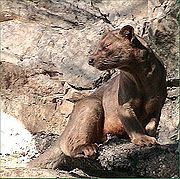 Family Eupleridae
Family Eupleridae
(the "Malagasy carnivorans") includes Fossa
, Falanouc
, Malagasy Civet and Malagasy mongooses
, all of which are restricted to the island of Madagascar
. There are eight species in the family though variations in form are significant. These differences initially led to the species in this family sharing common names with, and being placed in the different families of, apparently more similar species on the mainland (e.g. civets and mongoose). However phylogenetic analysis of DNA
provides strong evidence that all Malagasy
carnivorans evolved from a single common ancestor that was a herpestid (Yoder et al. 2003).[6a,6b] Recent phylogenetic analysis supports this view and places all of the Malagasy carnivorans in the family Eupleridae (Gaubert et al. 2005).[7]
The differences in form make it difficult to concisely summarise the species in this family. The range in size is as diverse as the range in form, with smaller species at less than 500 g (1 lb) and the largest species at up to 12 kg (26 lb). Some have retractile or semi-retractile claws (the Fossa and the Malagasy Civet) and others do not (the Falanouc and Malagasy mongooses). They all tend to have slender bodies and pointed rostra (except the Fossa which has a blunt snout). Diet varies with size and form of the species and, like their mainland counterparts, ranges from small mammals, insects and invertebrates through to crustaceans and molluscs.
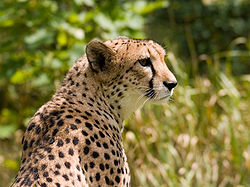 Family Felidae
Family Felidae
(Domestic Cats, Tiger
, Lion
, Ocelot
, etc.) are the best-known of "cat-like" carnivorans. There are 41 extant species, and all but a few have retractile claws. This family is represented on all continents except Australia (where domestic cats have been introduced
) and the Antarctic. The species vary in size from the tiny Black-footed Cat
(Felis nigripes) at only 2 kg (4.5 lb) to the Tiger
(Panthera tigris) at 300 kg (660 lb). Diet ranges from large to small mammals, bird
s and insects (depending on species size.)
Family Hyaenidae (hyena
s and Aardwolf
) has four extant species and two subspecies. All show features of convergent evolution
with canids, including non-retractile claws, long muzzles, and adaptations to running for long distances. They are extant in the Middle East
, India
and Africa
. Hyenas are large, powerful animals, up to 80 kg (176 lb) and represent one of the most prolific large carnivorans on the planet. The Aardwolf
is much smaller at 27 kg (60 lb) and is a specialised feeder, eating mainly harvester termites.
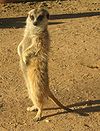 Family Herpestidae (the Mongoose
Family Herpestidae (the Mongoose
s, kusimanses
, Meerkat
, etc.) has 32 species. Previously, these were placed in the Viverridae family. However, Wilson and Reeder (1993) established the herpestids as morphologically and genetically distinct from viverrids. They are extant in Africa, Middle East and Asia
. All have non-retractile claws. They are smaller as a family, ranging from 1 kg (2.2 lb) to 5 kg (11 lb), and typically have long, slender bodies and short legs. Diet varies based on species size and available food sources, ranging from small mammals, birds to reptile
s, insects and crab
s. Some species are omnivorous
, including fruit
s and tuber
s in their diet.
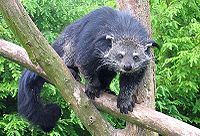 Family Nandiniidae (African Palm Civet
Family Nandiniidae (African Palm Civet
) has only one species (Nandinia binotata), extant across sub-Saharan Africa
. They have retractile claws and are slender-bodied, arboreal omnivores (with fruit making up much of their diet). They are relatively small with the larger males weighing up to 5 kg (11 lb).
Family Viverridae (the Binturong
, civet
s, genet
s, Asiatic and African linsang
) has 30 extant species and all have retractile claws. They are extant in Southern Europe, Africa and Asia. They range in size from 500g (1 lb) up to medium-sized carnivorans at 14 kg (39 lb). They have long bodies and short legs and usually have long tails (some prehensile). Diet ranges from small mammals and insects through to crustacean
s and molluscs.
 In the Middle Palaeocene (60 million years ago), Miacoidea
In the Middle Palaeocene (60 million years ago), Miacoidea
appears. Miacoids were a group of paraphyletic taxa believed to be basal to Carnivora. They had Carnivora-like carnassials but lacked fully ossified auditory bullae. Miacids were small arboreal carnivorans and, based on their size (roughly that of mongooses), they probably fed on insects, small mammals and birds.
The miacoids are divided into two groups: the miacids, with a full complement of molars, and the viverravines with a reduced number of molars and more specialized carnassials. These dental differences resemble the difference between Caniforms (with more teeth) and Feliforms (with fewer teeth) but this may not mean evolutionary lineages. It was thought that Viverravidae was basal to the Feliforms. However, recent studies suggest this is not the case (Wesley-Hunt and John J. Flynn 2005).[5]
In the Middle Eocene
(about 42 mya) the miacids started to branch into two distinct groups of the order Carnivora: the Feliforms and Caniforms. The miacid precursors to the extant Feliforms remained forest-dwelling, arboreal or semi-arboreal ambush hunters, while the Caniform precursors were more mobile, opportunistic hunters. While it is clear the first Feliforms appeared at this time, there is no clear common ancestor of the Feliform families in the fossil records. As forest dwellers, the early Feliforms were subject to more rapid decomposition in the absence of sedimentary materials, resulting in large gaps in the fossil records.
For more discussion on feliform evolution and the divergence from the caniforms, together with additional external references on this subject, see the articles on Carnivora
, Miacoidea
and Carnivoramorpha
.
The diagram below presents a contemporary (2010) view of feliform evolution and familial relationships (cladogram
) overlaid onto the geological time scale
. The information presented is based on fossil records and systematic classifications.
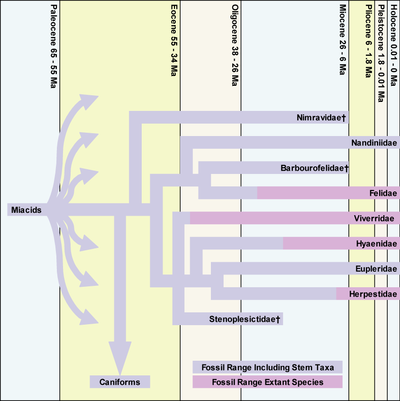
Carnivora
The diverse order Carnivora |Latin]] carō "flesh", + vorāre "to devour") includes over 260 species of placental mammals. Its members are formally referred to as carnivorans, while the word "carnivore" can refer to any meat-eating animal...
and includes cats
Felidae
Felidae is the biological family of the cats; a member of this family is called a felid. Felids are the strictest carnivores of the thirteen terrestrial families in the order Carnivora, although the three families of marine mammals comprising the superfamily pinnipedia are as carnivorous as the...
(large and small), hyenas, mongooses, civet
Civet
The family Viverridae is made up of around 30 species of medium-sized mammal, including all of the genets, the binturong, most of the civets, and the two African linsangs....
s and related taxa. The other suborder of Carnivora is Caniformia
Caniformia
Caniformia, or Canoidea , is a suborder within the order Carnivora. They typically possess a long snout and non-retractile claws . The Pinnipedia evolved from caniform ancestors and are accordingly assigned to this group...
("dog-like" carnivorans). One shared characteristic distinguishes Carnivora from all other mammals: the possession of the four carnassial
Carnassial
Carnassials are large teeth found in many carnivorous mammals, used for shearing flesh and bone in a scissor- or shear-like way. In the Carnivora, the carnassials are the modified last upper premolar and the first molar, but in the prehistoric creodonts, the carnassials were further back in the...
teeth in the front of the jaw.
The separation of Carnivora into the broad groups of feliforms and caniforms is widely accepted, as is the definition of Feliformia and Caniformia as suborders (sometimes superfamilies). The classification of feliforms as part of the Feliformia suborder or under separate groupings continues to evolve.
Systematic classifications dealing with only extant taxa[1,2] include all feliforms into the Feliformia suborder, though variations exist in the definition and grouping of families and genera. The extant families as reflected in the taxa chart at right and the discussions in this article reflect the most contemporary and well supported views (as at the time of writing this article). Molecular phylogenies show the Feliformia to be monophyletic[8].
Systematic classifications dealing with both extant and extinct taxa vary more widely. Some [4] separate the feliforms (extant and extinct) as: Aeluroidea (superfamily) and Feliformia (suborder). Others[3] include all feliforms (extant, extinct and "possible ancestors") into the Feliformia suborder. Recent studies suggest this inclusion of "possible ancestors" into Feliformia (or even Carnivora) may be spurious (Wesley-Hunt and Flynn 2005).[5] The extinct (†) families as reflected in the taxa chart at right are the least problematic in terms of their relationship with extant feliforms (with the most problematic being Nimravidae).
Characteristics

Auditory system
The auditory system is the sensory system for the sense of hearing.- Outer ear :The folds of cartilage surrounding the ear canal are called the pinna...
bullae (bony capsules enclosing the middle
Middle ear
The middle ear is the portion of the ear internal to the eardrum, and external to the oval window of the cochlea. The mammalian middle ear contains three ossicles, which couple vibration of the eardrum into waves in the fluid and membranes of the inner ear. The hollow space of the middle ear has...
and inner ear
Inner ear
The inner ear is the innermost part of the vertebrate ear. In mammals, it consists of the bony labyrinth, a hollow cavity in the temporal bone of the skull with a system of passages comprising two main functional parts:...
). This is a key diagnostic in classifying species as feliform versus caniform. In feliforms the auditory bullae are double-chambered, composed of two bones joined by a septum
Septum
In anatomy, a septum is a wall, dividing a cavity or structure into smaller ones.-In human anatomy:...
. Caniforms have single-chambered or partially divided auditory bullae, composed of a single bone.
The specific characteristics of extant feliform bullae suggest a common ancestor, though one has not been identified in the fossil
Fossil
Fossils are the preserved remains or traces of animals , plants, and other organisms from the remote past...
records. There are other characteristics that differentiate feliforms from caniforms and probably existed in their stem taxa. But due to speciation these do not apply unambiguously to all extant species.
Feliforms tend to have shorter rostrum
Rostrum (anatomy)
The term rostrum is used for a number of unrelated structures in different groups of animals:*In crustaceans, the rostrum is the forward extension of the carapace in front of the eyes....
s than caniforms, fewer teeth, and more specialized carnassial
Carnassial
Carnassials are large teeth found in many carnivorous mammals, used for shearing flesh and bone in a scissor- or shear-like way. In the Carnivora, the carnassials are the modified last upper premolar and the first molar, but in the prehistoric creodonts, the carnassials were further back in the...
s. Feliforms tend to be more carnivorous and are generally ambush hunters. Caniforms tend more toward omnivorous and opportunity-based feeders.
Many feliforms have retractile (retractable) or semi-retractile claws and many are arboreal or semi-arboreal. Feliforms also tend to be more digitigrade
Digitigrade
A digitigrade is an animal that stands or walks on its digits, or toes. Digitigrades include walking birds , cats, dogs, and many other mammals, but not plantigrades or unguligrades...
(walking on toes). In contrast, most caniforms are terrestrial, have non-retractile claws and tend to be plantigrade
Plantigrade
right|151px|thumb|Human skeleton, showing plantigrade habitIn terrestrial animals, plantigrade locomotion means walking with the podials and metatarsals flat on the ground. It is one of three forms of locomotion adopted by mammals...
.
Extant families
There are six extant families, twelve subfamilies, 56 genera and 114 species in the Feliformia suborder. They range natively across all continents except AustraliaAustralia
Australia , officially the Commonwealth of Australia, is a country in the Southern Hemisphere comprising the mainland of the Australian continent, the island of Tasmania, and numerous smaller islands in the Indian and Pacific Oceans. It is the world's sixth-largest country by total area...
and Antarctica. Most species are arboreal or semi-arboreal ambush hunters. Target prey varies based on the species size and available food sources (with the larger species feeding mainly on large mammals and the smallest species feeding on insect
Insect
Insects are a class of living creatures within the arthropods that have a chitinous exoskeleton, a three-part body , three pairs of jointed legs, compound eyes, and two antennae...
s or invertebrate
Invertebrate
An invertebrate is an animal without a backbone. The group includes 97% of all animal species – all animals except those in the chordate subphylum Vertebrata .Invertebrates form a paraphyletic group...
s).
An overview of each family is provided here. For detailed taxa and descriptions of the species in each family, follow the links to other articles and external references.

Eupleridae
The family Eupleridae is a group of carnivorans endemic to Madagascar and comprising 10 known species in seven genera. Probably the best known species is the Fossa , in the subfamily Euplerinae...
(the "Malagasy carnivorans") includes Fossa
Fossa (animal)
The fossa is a cat-like, carnivorous mammal that is endemic to Madagascar. It is a member of the Eupleridae, a family of carnivorans closely related to the mongoose family . Its classification has been controversial because its physical traits resemble those of cats, yet other traits suggest a...
, Falanouc
Falanouc
The Falanouc is a rare mongoose-like mammal endemic Malagasy euplerid .It is classified alongside its closest living relative, the Fanaloka, in the subfamily Euplerinae. The Falanouc has several peculiarities which merit its independent classification...
, Malagasy Civet and Malagasy mongooses
Galidiinae
Galidiinae is a subfamily of carnivorans restricted to Madagascar which includes six species classified into four genera. Together with the three other species of indigenous Malagasy carnivorans, including the fossa, they are currently classified in the family Eupleridae within the suborder...
, all of which are restricted to the island of Madagascar
Madagascar
The Republic of Madagascar is an island country located in the Indian Ocean off the southeastern coast of Africa...
. There are eight species in the family though variations in form are significant. These differences initially led to the species in this family sharing common names with, and being placed in the different families of, apparently more similar species on the mainland (e.g. civets and mongoose). However phylogenetic analysis of DNA
DNA
Deoxyribonucleic acid is a nucleic acid that contains the genetic instructions used in the development and functioning of all known living organisms . The DNA segments that carry this genetic information are called genes, but other DNA sequences have structural purposes, or are involved in...
provides strong evidence that all Malagasy
Malagasy fauna
The fauna of Madagascar is a part of the wildlife of Madagascar.Madagascar has been an isolated island for about 70 HI million years, breaking away from Africa around 165 million years ago, then from India nearly 100 million years later...
carnivorans evolved from a single common ancestor that was a herpestid (Yoder et al. 2003).[6a,6b] Recent phylogenetic analysis supports this view and places all of the Malagasy carnivorans in the family Eupleridae (Gaubert et al. 2005).[7]
The differences in form make it difficult to concisely summarise the species in this family. The range in size is as diverse as the range in form, with smaller species at less than 500 g (1 lb) and the largest species at up to 12 kg (26 lb). Some have retractile or semi-retractile claws (the Fossa and the Malagasy Civet) and others do not (the Falanouc and Malagasy mongooses). They all tend to have slender bodies and pointed rostra (except the Fossa which has a blunt snout). Diet varies with size and form of the species and, like their mainland counterparts, ranges from small mammals, insects and invertebrates through to crustaceans and molluscs.

Felidae
Felidae is the biological family of the cats; a member of this family is called a felid. Felids are the strictest carnivores of the thirteen terrestrial families in the order Carnivora, although the three families of marine mammals comprising the superfamily pinnipedia are as carnivorous as the...
(Domestic Cats, Tiger
Tiger
The tiger is the largest cat species, reaching a total body length of up to and weighing up to . Their most recognizable feature is a pattern of dark vertical stripes on reddish-orange fur with lighter underparts...
, Lion
Lion
The lion is one of the four big cats in the genus Panthera, and a member of the family Felidae. With some males exceeding 250 kg in weight, it is the second-largest living cat after the tiger...
, Ocelot
Ocelot
The ocelot , pronounced /ˈɒsəˌlɒt/, also known as the dwarf leopard or McKenney's wildcat is a wild cat distributed over South and Central America and Mexico, but has been reported as far north as Texas and in Trinidad, in the Caribbean...
, etc.) are the best-known of "cat-like" carnivorans. There are 41 extant species, and all but a few have retractile claws. This family is represented on all continents except Australia (where domestic cats have been introduced
Introduced species
An introduced species — or neozoon, alien, exotic, non-indigenous, or non-native species, or simply an introduction, is a species living outside its indigenous or native distributional range, and has arrived in an ecosystem or plant community by human activity, either deliberate or accidental...
) and the Antarctic. The species vary in size from the tiny Black-footed Cat
Black-footed Cat
The black-footed cat is the smallest African cat, and is endemic in the south west arid zone of the southern African subregion. It is one of the lesser studied African carnivores, and has been listed as Vulnerable by IUCN since 2002....
(Felis nigripes) at only 2 kg (4.5 lb) to the Tiger
Tiger
The tiger is the largest cat species, reaching a total body length of up to and weighing up to . Their most recognizable feature is a pattern of dark vertical stripes on reddish-orange fur with lighter underparts...
(Panthera tigris) at 300 kg (660 lb). Diet ranges from large to small mammals, bird
Bird
Birds are feathered, winged, bipedal, endothermic , egg-laying, vertebrate animals. Around 10,000 living species and 188 families makes them the most speciose class of tetrapod vertebrates. They inhabit ecosystems across the globe, from the Arctic to the Antarctic. Extant birds range in size from...
s and insects (depending on species size.)
Family Hyaenidae (hyena
Hyena
Hyenas or Hyaenas are the animals of the family Hyaenidae of suborder feliforms of the Carnivora. It is the fourth smallest biological family in the Carnivora , and one of the smallest in the mammalia...
s and Aardwolf
Aardwolf
The aardwolf is a small, insectivorous mammal, native to Eastern and Southern Africa. The name means "earth wolf" in Afrikaans/Dutch. It is also called "maanhaar jackal". It is related to hyenas, but unlike its relatives, it does not hunt large prey. This unusual animal preys on insects...
) has four extant species and two subspecies. All show features of convergent evolution
Convergent evolution
Convergent evolution describes the acquisition of the same biological trait in unrelated lineages.The wing is a classic example of convergent evolution in action. Although their last common ancestor did not have wings, both birds and bats do, and are capable of powered flight. The wings are...
with canids, including non-retractile claws, long muzzles, and adaptations to running for long distances. They are extant in the Middle East
Middle East
The Middle East is a region that encompasses Western Asia and Northern Africa. It is often used as a synonym for Near East, in opposition to Far East...
, India
India
India , officially the Republic of India , is a country in South Asia. It is the seventh-largest country by geographical area, the second-most populous country with over 1.2 billion people, and the most populous democracy in the world...
and Africa
Africa
Africa is the world's second largest and second most populous continent, after Asia. At about 30.2 million km² including adjacent islands, it covers 6% of the Earth's total surface area and 20.4% of the total land area...
. Hyenas are large, powerful animals, up to 80 kg (176 lb) and represent one of the most prolific large carnivorans on the planet. The Aardwolf
Aardwolf
The aardwolf is a small, insectivorous mammal, native to Eastern and Southern Africa. The name means "earth wolf" in Afrikaans/Dutch. It is also called "maanhaar jackal". It is related to hyenas, but unlike its relatives, it does not hunt large prey. This unusual animal preys on insects...
is much smaller at 27 kg (60 lb) and is a specialised feeder, eating mainly harvester termites.

Mongoose
Mongoose are a family of 33 living species of small carnivorans from southern Eurasia and mainland Africa. Four additional species from Madagascar in the subfamily Galidiinae, which were previously classified in this family, are also referred to as "mongooses" or "mongoose-like"...
s, kusimanses
Crossarchus
Crossarchus is a genus of mongoose, commonly referred to as the kusimanse, mangue, or dwarf mongoose.-Range and habitat:...
, Meerkat
Meerkat
The meerkat or suricate, Suricata suricatta, is a small mammal belonging to the mongoose family. Meerkats live in all parts of the Kalahari Desert in Botswana, in much of the Namib Desert in Namibia and southwestern Angola, and in South Africa. A group of meerkats is called a "mob", "gang" or "clan"...
, etc.) has 32 species. Previously, these were placed in the Viverridae family. However, Wilson and Reeder (1993) established the herpestids as morphologically and genetically distinct from viverrids. They are extant in Africa, Middle East and Asia
Asia
Asia is the world's largest and most populous continent, located primarily in the eastern and northern hemispheres. It covers 8.7% of the Earth's total surface area and with approximately 3.879 billion people, it hosts 60% of the world's current human population...
. All have non-retractile claws. They are smaller as a family, ranging from 1 kg (2.2 lb) to 5 kg (11 lb), and typically have long, slender bodies and short legs. Diet varies based on species size and available food sources, ranging from small mammals, birds to reptile
Reptile
Reptiles are members of a class of air-breathing, ectothermic vertebrates which are characterized by laying shelled eggs , and having skin covered in scales and/or scutes. They are tetrapods, either having four limbs or being descended from four-limbed ancestors...
s, insects and crab
Crab
True crabs are decapod crustaceans of the infraorder Brachyura, which typically have a very short projecting "tail" , or where the reduced abdomen is entirely hidden under the thorax...
s. Some species are omnivorous
Omnivore
Omnivores are species that eat both plants and animals as their primary food source...
, including fruit
Fruit
In broad terms, a fruit is a structure of a plant that contains its seeds.The term has different meanings dependent on context. In non-technical usage, such as food preparation, fruit normally means the fleshy seed-associated structures of certain plants that are sweet and edible in the raw state,...
s and tuber
Tuber
Tubers are various types of modified plant structures that are enlarged to store nutrients. They are used by plants to survive the winter or dry months and provide energy and nutrients for regrowth during the next growing season and they are a means of asexual reproduction...
s in their diet.

African Palm Civet
The African palm civet , also known as the two-spotted palm civet, is a small mammal, with short legs, small ears, a body resembling a cat, and a long lithe tail as long as its body. Adults usually weigh . It is native to the forests of eastern Africa, where it usually inhabits trees...
) has only one species (Nandinia binotata), extant across sub-Saharan Africa
Sub-Saharan Africa
Sub-Saharan Africa as a geographical term refers to the area of the African continent which lies south of the Sahara. A political definition of Sub-Saharan Africa, instead, covers all African countries which are fully or partially located south of the Sahara...
. They have retractile claws and are slender-bodied, arboreal omnivores (with fruit making up much of their diet). They are relatively small with the larger males weighing up to 5 kg (11 lb).
Family Viverridae (the Binturong
Binturong
The Binturong , also known as the Asian Bearcat, the Palawan Bearcat, or simply the Bearcat, is a species of the family Viverridae, which includes the civets and genets. It is the only member of its genus...
, civet
Civet
The family Viverridae is made up of around 30 species of medium-sized mammal, including all of the genets, the binturong, most of the civets, and the two African linsangs....
s, genet
Genet (animal)
Genets are Old World mammals from the order Carnivora, family Viverridae, related to civets and linsangs. All species are contained within the genus Genetta, although the Aquatic Genet is sometimes housed in its own genus Osbornictis....
s, Asiatic and African linsang
African Linsang
The African Linsang is a species of linsang in the family Viverridae. It is endemic to Cameroon, the Central African Republic, the Democratic Republic of the Congo, Equatorial Guinea, Gabon, and the Republic of the Congo. The African linsang is a largely arboreal creature...
) has 30 extant species and all have retractile claws. They are extant in Southern Europe, Africa and Asia. They range in size from 500g (1 lb) up to medium-sized carnivorans at 14 kg (39 lb). They have long bodies and short legs and usually have long tails (some prehensile). Diet ranges from small mammals and insects through to crustacean
Crustacean
Crustaceans form a very large group of arthropods, usually treated as a subphylum, which includes such familiar animals as crabs, lobsters, crayfish, shrimp, krill and barnacles. The 50,000 described species range in size from Stygotantulus stocki at , to the Japanese spider crab with a leg span...
s and molluscs.
Evolution

Miacoidea
Miacoidea is paraphyletic superfamily that had been traditionally divided into two families of carnivores: Miacidae and Viverravidae. Miacoids were primitive carnivores which lived during the Paleocene and Eocene Epoch about 33-65 million years ago...
appears. Miacoids were a group of paraphyletic taxa believed to be basal to Carnivora. They had Carnivora-like carnassials but lacked fully ossified auditory bullae. Miacids were small arboreal carnivorans and, based on their size (roughly that of mongooses), they probably fed on insects, small mammals and birds.
The miacoids are divided into two groups: the miacids, with a full complement of molars, and the viverravines with a reduced number of molars and more specialized carnassials. These dental differences resemble the difference between Caniforms (with more teeth) and Feliforms (with fewer teeth) but this may not mean evolutionary lineages. It was thought that Viverravidae was basal to the Feliforms. However, recent studies suggest this is not the case (Wesley-Hunt and John J. Flynn 2005).[5]
In the Middle Eocene
Eocene
The Eocene Epoch, lasting from about 56 to 34 million years ago , is a major division of the geologic timescale and the second epoch of the Paleogene Period in the Cenozoic Era. The Eocene spans the time from the end of the Palaeocene Epoch to the beginning of the Oligocene Epoch. The start of the...
(about 42 mya) the miacids started to branch into two distinct groups of the order Carnivora: the Feliforms and Caniforms. The miacid precursors to the extant Feliforms remained forest-dwelling, arboreal or semi-arboreal ambush hunters, while the Caniform precursors were more mobile, opportunistic hunters. While it is clear the first Feliforms appeared at this time, there is no clear common ancestor of the Feliform families in the fossil records. As forest dwellers, the early Feliforms were subject to more rapid decomposition in the absence of sedimentary materials, resulting in large gaps in the fossil records.
For more discussion on feliform evolution and the divergence from the caniforms, together with additional external references on this subject, see the articles on Carnivora
Carnivora
The diverse order Carnivora |Latin]] carō "flesh", + vorāre "to devour") includes over 260 species of placental mammals. Its members are formally referred to as carnivorans, while the word "carnivore" can refer to any meat-eating animal...
, Miacoidea
Miacoidea
Miacoidea is paraphyletic superfamily that had been traditionally divided into two families of carnivores: Miacidae and Viverravidae. Miacoids were primitive carnivores which lived during the Paleocene and Eocene Epoch about 33-65 million years ago...
and Carnivoramorpha
Carnivoramorpha
Carnivoramorpha are a clade of mammals that includes the modern order Carnivora and its closest extinct relatives in the Miacoidea , but excludes the creodonts. The order Creodonta are a sister taxon to the Carnivoramorpha dating back 58.7 million years ago...
.
The diagram below presents a contemporary (2010) view of feliform evolution and familial relationships (cladogram
Cladistics
Cladistics is a method of classifying species of organisms into groups called clades, which consist of an ancestor organism and all its descendants . For example, birds, dinosaurs, crocodiles, and all descendants of their most recent common ancestor form a clade...
) overlaid onto the geological time scale
Geologic time scale
The geologic time scale provides a system of chronologic measurement relating stratigraphy to time that is used by geologists, paleontologists and other earth scientists to describe the timing and relationships between events that have occurred during the history of the Earth...
. The information presented is based on fossil records and systematic classifications.


